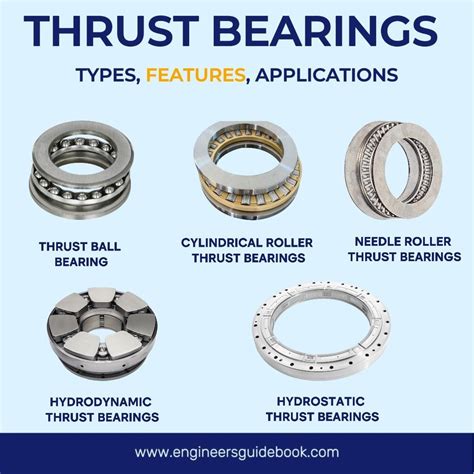Unlocking the Power of Thrust Bearings: Precision, Efficiency, and Reliability
Thrust bearings play a critical role in modern machinery, enabling smooth rotation and efficient power transmission. Their unique design and exceptional performance characteristics make them indispensable components in a wide range of applications. This comprehensive guide explores the world of thrust bearings, uncovering their types, advantages, drawbacks, and practical applications.
Understanding Thrust Bearings
Thrust bearings are specialized bearings designed to support axial loads, which are forces acting parallel to the shaft axis. Unlike radial bearings that carry radial loads, thrust bearings prevent axial displacement while allowing free rotational motion. Their unique design features a set of thrust washers or thrust plates that enable axial load support.
Types of Thrust Bearings
1. Ball Thrust Bearings
* Consist of ball bearings held in a cage, providing high-speed operation and low friction.
2. Cylindrical Roller Thrust Bearings
* Utilize cylindrical rollers for heavy axial loads and moderate speeds.

3. Spherical Roller Thrust Bearings
* Incorporate spherical rollers for self-aligning capabilities and high-load capacity.

4. Tapered Roller Thrust Bearings
* Feature tapered rollers that can handle combined axial and radial loads.

Advantages of Thrust Bearings
-
Axial Load Support: Primary advantage is axial load support, providing stability and preventing axial displacement.
-
Smooth Rotation: Designed to minimize friction and ensure smooth rotational motion.
-
High Load Capacity: Specific designs can support substantial axial loads, making them suitable for heavy-duty applications.
-
Compact Design: Can offer compact solutions for space-constrained applications.
-
Versatility: Applicable in various industries and applications, from wind turbines to machine tools.
Potential Drawbacks
-
Limited Radial Load Capacity: Not designed for significant radial loads, which may require additional support.
-
Sensitivity to Misalignment: Misalignment can adversely affect performance and reduce bearing life.
-
Lubrication Requirements: May require specialized lubrication systems to maintain optimal performance.
Comparing Pros and Cons
| Pros |
Cons |
| Axial load support |
Limited radial load capacity |
| Smooth rotation |
Sensitivity to misalignment |
| High load capacity |
Lubrication requirements |
| Compact design |
Can be more expensive than radial bearings |
| Versatility |
May have size limitations |
Practical Applications
Thrust bearings find widespread use in numerous industries, including:
-
Wind Turbines: Support the rotating shaft and blade assemblies.
-
Machine Tools: Provide axial support for spindles and rotating tables.
-
Automotive: Used in transmissions, differentials, and steering systems.
-
Aerospace: Support axial loads in engines and landing gear.
-
Industrial Machinery: Found in heavy-duty pumps, compressors, and turbines.
Sizing and Selection
Selecting the appropriate thrust bearing involves considering factors such as axial load, speed, lubrication requirements, and operating conditions. Proper sizing ensures optimal performance and longevity.
Lubrication
Thrust bearings typically require specialized lubrication systems to maintain low friction and prevent wear. Common lubrication methods include oil jets, grease, and circulating oil systems.
Installation and Maintenance
Proper installation and maintenance are crucial for ensuring optimal performance and extending bearing life. Follow manufacturer's instructions for installation, alignment, and lubrication maintenance.
Stories from the Field
-
The Misaligned Machine: A technician troubleshooting a malfunctioning machine discovered a misaligned thrust bearing. Correcting the alignment significantly improved machine performance.
-
The Overlooked Lubrication: A bearing failure occurred due to insufficient lubrication. Regular lubrication maintenance would have prevented the costly repair.
-
The Bearing with a Second Life: A damaged thrust bearing was repaired by replacing worn components, extending its service life and saving on replacement costs.
What We Learn from These Stories
- Proper alignment is essential for optimizing thrust bearing performance.
- Regular lubrication maintenance is crucial for extending bearing life.
- Repairing damaged bearings can be a cost-effective solution.
FAQs
- What is the difference between a thrust bearing and a radial bearing?
- What is the maximum axial load a thrust bearing can support?
- How often should a thrust bearing be lubricated?
- What are the common causes of thrust bearing failure?
- How can I extend the life of my thrust bearing?
- Is it possible to repair a damaged thrust bearing?
Conclusion
Thrust bearings are essential components in modern machinery, providing axial load support, smooth rotation, and high load capacity. By understanding their types, advantages, drawbacks, and practical applications, engineers and technicians can optimize bearing performance and reliability. Proper sizing, lubrication maintenance, and installation ensure maximum efficiency, durability, and cost savings in a wide range of industries.

